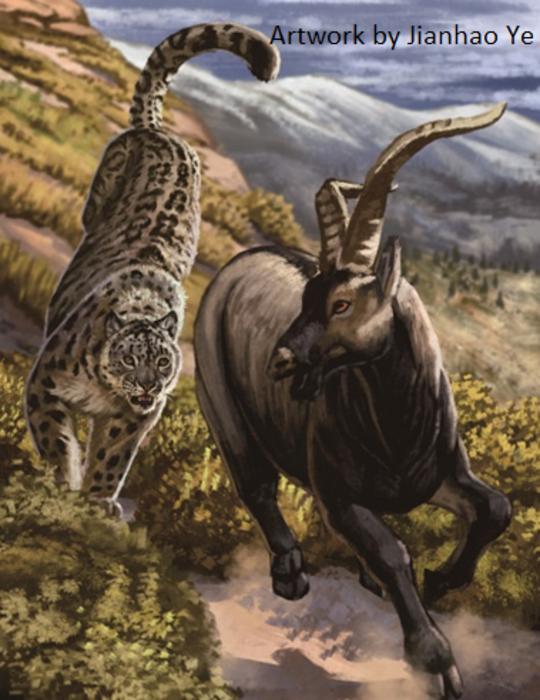Contemporary snow leopards are rare — and fossils of their ancient ancestors are even more scarce. Researchers have now identified and examined million-year-old bones of the big cat and have come to some surprising conclusions about how it adapted to the Ice Age and survived as a species since then. Their analysis has been published in the journal Science Advances.
Learning About Snow Leopard Survival
The skull of the leopard of Algar da Manga Larga, deposited at the Geological Museum of Lisbon. © (Credit: Darío Estraviz-López©, 2019)
Common leopards appear engineered to hunt quick, nimble prey. Features like large teeth, domed skulls, and strong jaws and paws maximize their ability to take down strong, agile prey such as mountain goats.
But leopards who lived in rocky, barren terrains — including snow leopards — needed even more specialized skills. Those include strong binocular vision, a skull shape that maximizes hearing, powerful limbs to absorb the impact of steep jumps, and a long tail for balance.
Read More: Top 10 Snow Animals and How They Survive the Cold
Ice Age Adaptations
Researchers have long thought those adaptations started during the last period of the Ice Age. Until this study, the best example of ancient leopard evolution came from a partial leopard skeleton, discovered in Portugal by amateur cavers, dispersed westward to the Iberian Peninsula.
The new study, which examines fossils of five snow leopards from China, France, and Portugal now connects the leopard of Algar da Manga Larga to the ancient snow leopard lineage in Western Europe. It also challenges the conventional wisdom of how and why the big cats adapted to a harsh environment.
The study proposes that glaciation in Eurasia around 900,000 years ago created more open spaces. That literally gave the big cats more room to roam. This theory goes against the notion that ancient snow leopards adapted to high, rocky places.
“The analyses we have carried out lead us to conclude that surely the high altitude and snow would not have been the limiting factor for the distribution of the species, but rather the presence of open and steep spaces,” Joan Madurell Malapeira, a researcher with Universitat Autònoma de Barcelona (UAB) and an author of the paper, said in a press release. “In other words, the snow leopard has always been adapted to live in the mountains, but not necessarily at high altitudes and with snow.”
Read More: Are Snow Leopards Endangered?
Hope for the Species’ Survival
If those reasons for adaptation prove true, it may be a positive sign for the species’ survival — of which only about 4,000 remain — despite a warming world. If they do, indeed depend more on flat rocky hunting grounds, rather than higher, steeper, snowy ones, they may have a better chance of surviving a warming world.
“This, in a context of climate change like the current one, is encouraging to ensure their survival,” said Malapeira in the release.
Article Sources
Our writers at Discovermagazine.com use peer-reviewed studies and high-quality sources for our articles, and our editors review for scientific accuracy and editorial standards. Review the sources used below for this article:
Before joining Discover Magazine, Paul Smaglik spent over 20 years as a science journalist, specializing in U.S. life science policy and global scientific career issues. He began his career in newspapers, but switched to scientific magazines. His work has appeared in publications including Science News, Science, Nature, and Scientific American.
Source : Discovermagazine






